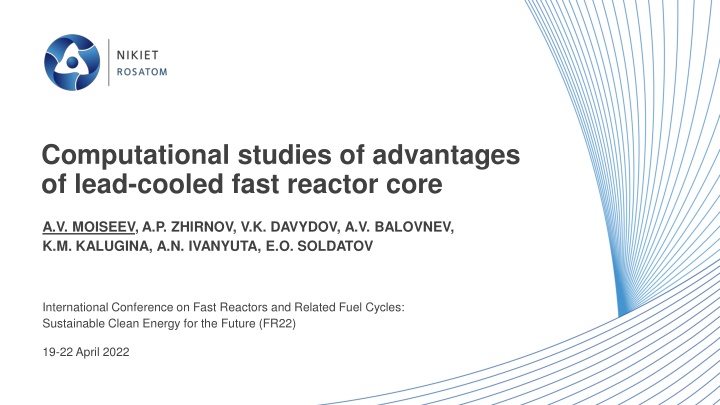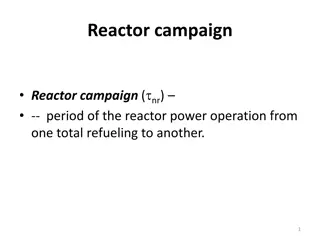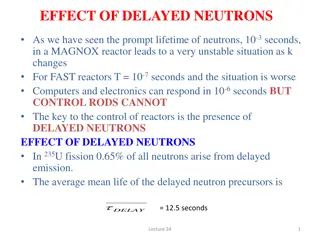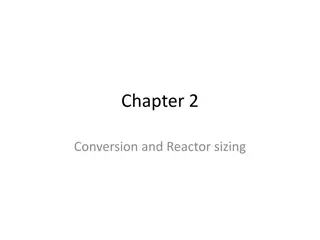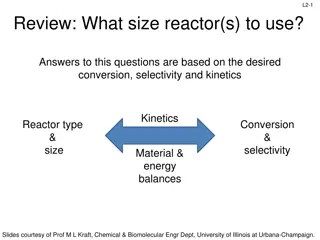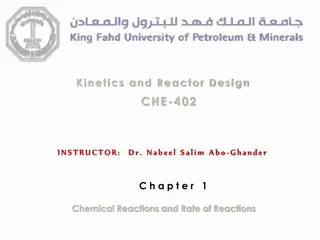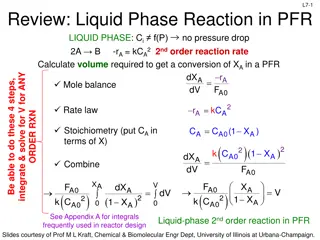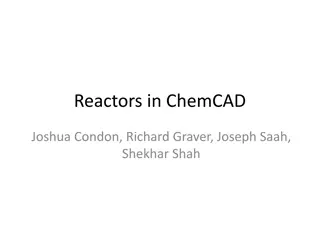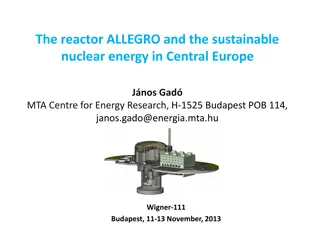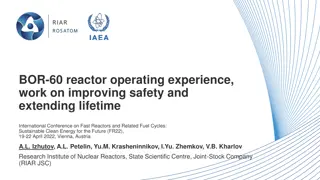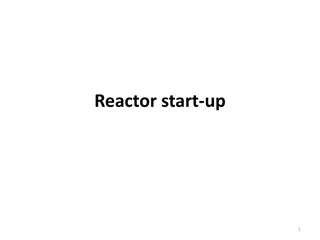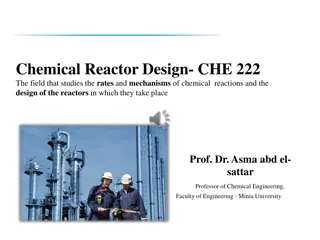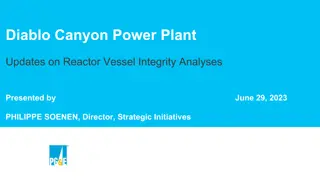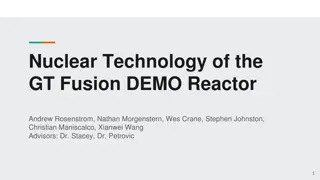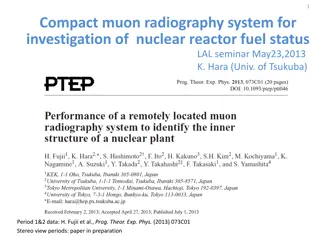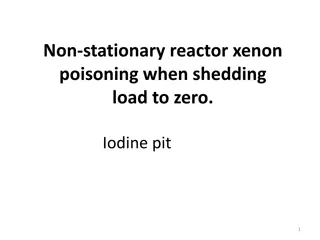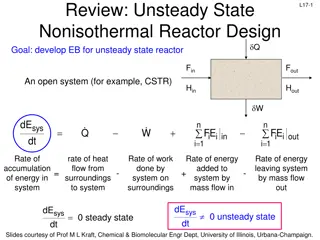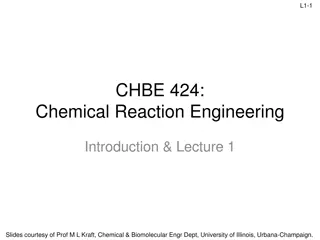Computational studies of advantages of lead-cooled fast reactor core
Design concept of the BREST lead-cooled fast reactor core focuses on preventing reactivity accidents by developing an equilibrium core with complete breeding of fissionable nuclides. The system of design codes for the BREST core includes high-precision neutron simulations, neutron-flux density field calculations, reactor operation simulations, and more for ensuring nuclear safety.
Download Presentation

Please find below an Image/Link to download the presentation.
The content on the website is provided AS IS for your information and personal use only. It may not be sold, licensed, or shared on other websites without obtaining consent from the author.If you encounter any issues during the download, it is possible that the publisher has removed the file from their server.
You are allowed to download the files provided on this website for personal or commercial use, subject to the condition that they are used lawfully. All files are the property of their respective owners.
The content on the website is provided AS IS for your information and personal use only. It may not be sold, licensed, or shared on other websites without obtaining consent from the author.
E N D
Presentation Transcript
Computational studies of advantages of lead-cooled fast reactor core A.V. MOISEEV, A.P. ZHIRNOV, V.K. DAVYDOV, A.V. BALOVNEV, K.M. KALUGINA, A.N. IVANYUTA, E.O. SOLDATOV International Conference on Fast Reactors and Related Fuel Cycles: Sustainable Clean Energy for the Future (FR22) 19-22 April 2022
Design concept of the BREST lead-cooled fast reactor core The goal is to prevent reactivity accidents (Chernobyl) with uncontrolled power increase when introducing the full reactivity margin because of equipment failures or personnel errors: o Development of an equilibrium core with complete breeding of fissionable nuclides in the core (core breeding ratio of ~ 1) without a blanket, compensating for reactivity reduction due to fuel burnup and fission-product buildup o This makes it possible to operate the reactor in the period between two regular refuelings with low reactivity margin (< eff) o Even in the case of unauthorized introduction of the full reactivity margin as a result of self- driving and withdrawal from the core of all CPS (not considered in other reactor types) acceleration on prompt neutrons with an increase in power is not realized At the same time, it is provided: Overall view of the BREST reactor o Efficient use of uranium by means of conversion of 238U to 239Pu in the fast reactor spectrum o Possibility of transmutation of the produced minor actinides (self and external) during the reactor operation in the closed nuclear fuel cycle 2
The system of design codes for the BREST core neutronic simulation Neutronics core calculations and nuclear safety justification was made by high-precision MCU-BR: FACT-BR designed to calculate neutronics of fast reactors using diffusion approximation. CONSYST neutron cross-section preparation system with the BNAB-93 library is used, To calculate 3D neutron-flux density field and power distribution 26-group diffusion approximation. Simulation of steady-state reactor operation at different power levels Simulation of reactor operation during nuclear fuel burnup Description of neutron field behavior Simulation of reactor operation in a partial refueling mode Analytical simulation of a closed nuclear fuel cycle (CNFC) Calculation of isotopic composition change during burnup Acquisition of fuel element-wise distribution of power density and burnup Calculation of CPS control member efficiency and reactivity effects; Estimation of spatial distribution of neutron fluence and levels of radiation damage of structural materials during burnup Simulation of photon transport using analog and non-analog (weighing) Monte-Carlo methods Kinetics parameters ( eff, prompt-neutron lifetime). IVIS-BR thermal physics module is designed for numerical simulation of steady-state and transient modes in the primary circuit of a liquid metal-cooled reactor. The module calculates coolant flow, pressure and temperature of fuel elements. The reactor core is simulated as a system of parallel channels, each of which represents an FA. MCU-BR high-precision software system based on the Monte-Carlo method. Analytical models of the MCU-BR code provide the most precise description of the geometry and composition of a core, reflectors and other components affecting neutronic characteristics of a reactor. MDBBR50 cross-section library is used. For this library the following files for estimated nuclear data were used: JENDL-4.0 (for 239Pu, 240Pu, 241Pu and lead isotopes), ENDF/B-VII.1 (for 235U, 238U, 56Fe), ROSFOND for other nuclides. 3
Validation of the codes. Assessment of computational uncertainties MCU-BR and FACT-BR have been validated for calculations of a lead-cooled reactor with nitride fuel. Experimental results obtained with the BN-350, BN-600, JOYO reactors were used for validation. Extensive series of experiments with lead was carried out at the BFS test facility; at various times, assemblies 61, 64, 77, 85, 87, 95, 113 were created. BFS-113 (2015) assembly with nitride was a benchmark model of the BREST-OD-300 reactor core. International benchmark model of the RBEC-M reactor with uranium-plutonium nitride fuel and LBE coolant. Other available experiments and benchmurks C-E/E, % Experimen t Assembly ROSFOND ENDF/B-7.1 JEFF-3.2 JENDL-4.0 CENDL-3.1 MDBBR50 61-0 (Pu) 1.0003 -0.14 -0.30 -0.35 0.31 0.28 0.23 61-1 (Pu) 1.0004 -0.42 -0.56 -0.65 0.04 -0.03 -0.04 61-2 (Pu) 1.0004 -0.43 -0.50 -0.56 0.03 0.00 -0.08 77-1 (U-Pu) 1.0004 0.12 -0.02 0.15 -0.20 0.22 0.10 77-1a (U-Pu) 1.001 0.09 -0.05 0.12 -0.25 0.19 0.07 85-1 (U) 1.0007 -0.18 0.00 0.47 -0.34 -0.66 -0.24 85-2 (U) 1.0021 -0.10 0.02 0.49 -0.29 -0.53 -0.17 95-1 (U-Pu) 1.0004 0.25 0.02 0.12 0.09 0.38 0.31 95-2 (U-Pu) 1.0004 0.13 -0.08 -0.01 0.00 0.30 0.21 113-1A (U-Pu) 1.0006 0.16 -0.11 0.03 -0.03 0.24 0.19 Estimated accuracy of the BREST reactor criticality calculation does not exceed 0.7 % k/k. However the calculation accuracy will be improved based on the results of validation of BREST-OD-300 itself during first criticality and power startup. 113-1B (U-Pu) 1.0011 0.12 -0.18 -0.04 -0.08 0.16 0.14 64-0 1.00040 0.16 0.18 0.01 0.05 0.04 -0.07 64-1 1.00110 0.11 0.12 0.07 0.005 0.10 0.002 0.23 0.25 0.34 0.19 0.32 0.18 , % max (C/E-1), % -0.43 -0.56 -0.65 -0.34 -0.66 0.31 4
Simulation of the BREST initial loading Fuel composition for the initial core loading was selected with compensation of excess reactivity of 1.36 % k/k taking into account possible manufacturing and calculation uncertainties. In the initial period of operation, the uncertainties are compensated by the fixed, immobilized constant reactivity compensators (CRC), which can only be removed when the reactor is shut down. A core layout with 9 CRCs was defined taking into account the requirement for power density field flattening across the core. Constant reactivity compensators (CRC) arrangement on the core map in the analytical model The actual decision on the place and number of installed CRC will be made upon the first formation of the critical core loading taking into account the moment of achieving the first criticality. Determined parameters of the initial loading Parameter Fuel density, g/cm3(20 ) Plutonium content in the mixture of uranium and plutonium isotopes, wt% Full reactor loading, t Uranium mass, t Plutonium mass, t Value 12.3 13.6 20.8 17.04 2.67 5 Formation of the starting loading. The graph shows the possible region of reaching the first criticality
Simulation of the initial operation period and transition to steady-state operation Full duration of the first campaign is 900 effective days; it is separated into 6 micro campaigns of 150 effective days with shutdowns for 33 days. During the first six semiannual cycles after the startup, the reactor operates without partial refuelings but with shutdowns; then it operates with partial refuelings in 150 effective days. When operating a core with a "zero" reactivity margin for fuel burnup during a micro campaign, all reactivity compensation (RC) control members and emergency protection (EP) control members are removed from the core. Only two pairs of automatic control (AC) members remain partially inserted, compensating for the neptunium effect of reactivity ~0.08 % k/k and small reactivity swings when isotopic composition of fuel in the core changes. Estimated characteristics of the initial period of operation Core characteristics Value Reactivity margin, eff(with Np effect) 0.54 Core breeding ratio 1.078 Maximum FA power (CZ/PZ), MW 6.04/4.38 Maximum linear heat rate, W/cm (CZ/PZ FAs) 406/341 Worth of EP system, % k/k 2.52 Worth of the EPR shutdown system, % k/k 4.47 Reactivity margin of BREST-OD-300 when operated at rated power (initial period of operation) Temperature and power effect of reactivity, % k/k - 0.576 Effective fraction of delayed neutrons, % k/k 0.357 6
Simulation of the BREST core operation 2.75 3.23 3.54 3.67 3.66 3.54 3.23 2.75 2.73 3.22 3.53 3.67 3.67 3.54 3.22 2.74 3.23 3.89 4.35 3.85 2.52 3.85 4.35 3.87 3.23 3.21 3.88 4.34 3.85 2.53 3.87 4.36 3.87 3.22 3.55 4.37 2.65 4.43 4.59 4.59 4.44 2.65 4.35 3.54 3.52 4.34 2.65 4.45 4.61 4.62 4.45 2.66 4.36 3.54 3.67 3.86 4.44 4.82 5.07 3.32 5.08 4.82 4.45 3.87 3.68 3.64 3.84 4.44 4.82 5.08 3.34 5.11 4.86 4.45 3.86 3.68 3.67 2.53 4.61 5.08 3.45 5.48 5.47 3.45 5.08 4.61 2.53 3.67 3.64 2.52 4.60 5.09 3.47 5.51 5.51 3.49 5.11 4.63 2.54 3.66 3.54 3.85 4.60 3.32 5.48 5.60 3.62 5.60 5.48 3.32 4.61 3.86 3.54 3.51 3.84 4.59 3.32 5.50 5.64 3.66 5.64 5.51 3.34 4.63 3.86 3.54 3.22 4.35 4.44 5.10 5.49 3.61 5.47 5.46 3.63 5.48 5.09 4.44 4.35 3.22 3.19 4.32 4.43 5.08 5.49 3.66 5.51 5.53 3.66 5.51 5.10 4.45 4.36 3.22 2.74 3.87 2.65 4.83 3.46 5.60 5.46 3.34 5.47 5.60 3.46 4.83 2.65 3.88 2.74 2.72 3.84 2.65 4.82 3.46 5.62 5.53 3.37 5.52 5.64 3.49 4.84 2.67 3.88 2.75 3.22 4.34 4.44 5.08 5.50 3.62 5.46 5.47 3.62 5.48 5.08 4.45 4.35 3.23 3.20 4.32 4.43 5.09 5.49 3.65 5.51 5.52 3.65 5.50 5.10 4.45 4.36 3.23 3.55 3.87 4.61 3.32 5.47 5.60 3.62 5.59 5.47 3.32 4.61 3.87 3.55 3.51 3.84 4.59 3.33 5.48 5.63 3.65 5.62 5.49 3.34 4.62 3.86 3.54 3.66 2.52 4.61 5.09 3.46 5.47 5.47 3.46 5.08 4.61 2.53 3.67 3.65 2.52 4.59 5.08 3.46 5.49 5.49 3.47 5.09 4.61 2.53 3.66 3.67 3.87 4.44 4.83 5.08 3.32 5.08 4.83 4.45 3.87 3.68 3.65 3.83 4.42 4.82 5.08 3.32 5.09 4.83 4.44 3.85 3.66 3.54 4.36 2.66 4.45 4.61 4.61 4.44 2.66 4.37 3.55 3.51 4.31 2.65 4.43 4.60 4.60 4.44 2.66 4.34 3.53 3.23 3.88 4.36 3.87 2.53 3.87 4.36 3.89 3.24 3.20 3.84 4.32 3.83 2.52 3.84 4.32 3.85 3.21 2.75 3.23 3.55 3.67 3.68 3.55 3.24 2.76 2.73 3.20 3.51 3.64 3.65 3.52 3.21 2.73 FA power in the fourth micro campaign, MW FA power in the first micro campaign, MW The equilibrium BREST reactor core features the unique stability of power density fields over a campaign FA power changes very slightly during the campaign regardless of fuel life and burnup. This feature makes it possible to use radial-annular refueling pattern instead of the uniform ones, which have traditionally been used for fast reactors. The radial-annular refueling pattern provides maximum power generation for each FA. After each micro campaign, batch of FAs with approximately the same fuel burnup is unloaded from the core. 7
Simulation of the closed nuclear fuel cycle Refuelings are carried out as the fuel burnup gets close to the limiting value in each refueling batch (10 % of h.a.). The spent FAs unloaded from the core are placed into IVS for decay heat drop for one micro campaign, then the spent FAs are unloaded from the reactor. The further period of postreactor decay, SNF reprocessing and regenerated fuel fabrication is set equal to 3 years. During refabrication, fission products and curium are completely removed from the fuel. Americium and neptunium isotopes are retained in the fuel. To obtain the plutonium fraction specified based on the calculation results, depleted uranium is added to the purified fuel. The use of plutonium extracted from VVER SNF is required only for the initial loading and first feedings of the core operating in the uranium-plutonium-actinide closed nuclear cycle in the partial refueling mode. Involvement of reactor-grade plutonium in the fuel cycle ensures its utilization and reduces its storage costs. The SNF reprocessing technology does not allow the extraction of fissile isotopes, which contributes to nonproliferation regime enhancement. The BREST-OD-300 core does not require involvement of enriched uranium in the fuel cycle. 8
Simulation of the the BREST-OD-300 campaign The BREST-OD-300 reactor campaign was simulated for the entire service life of 30 years. The total campaign duration is 9000 effective days and it is broken down into 36 micro campaigns. The duration of micro campaigns ranges from 150 to 300 effective days with shutdowns for 33 to 65 days for refueling. The reactivity margin change throughout life is adjusted by the number of reloaded FAs and characteristics of fresh loaded fuel. After each micro campaign, 18 to 36 FAs with a fuel density of 12.3-12.5 g/cm3 and plutonium mass fraction of 13.0-13.6 % are reloaded. Reactivity margin change over the BREST-OD-300 campaign Partial refuelings are carried out either with fresh fuel from the initial loading or with reprocessed fuel obtained by reprocessing the spent fuel unloaded from the reactor. The maximum change in reactivity over all micro campaigns ~ 0.6 eff The core breeding ratio over campaign ranges from 1.02 to 1.06. Throughout the entire BREST-OD-300 service life (30 years), the core can be operated with a low reactivity margin and a breeding ratio slightly exceeding 1. 9 Core breeding ratio change over the BREST-OD-300 campaign
Capabilities of computational simulation of large commercial lead-cooled fast reactors When simulating the BR-1200 reactor, the same approaches are used. But there are also some peculiarities: Calculations of a large core with a significantly larger number of FAs (397 instead of 169) and higher fuel column (150 cm instead of 110 cm) are performed while ensuring as detailed as possible description of core components. A commercial reactor is characterized by a higher fuel burnup, a longer FA service life (damaging dose), a longer reactor service life, and, accordingly, the entire fuel life (60 years instead of 30); a higher neutron flux in the core: 5.7 1015instead of 3.5 10151/(cm2 s). In a geometrically large extended core, it is necessary to pay more attention to flattening the power density fields and non-exceedance of the limiting temperatures of fuel claddings taking into account the shroudless design of FAs and the coolant flow control by fuel element diameters. FA power distribution for BR-1200 reactor (calculated using FACT-BR), MW 10
Conclusion The system of design codes was developed to carry out calculation studies of the BREST reactor core: FACT-BR diffusion software system, MCU-BR software tool based on the Monte-Carlo method, and the IVIS-BR thermophysics module. The design codes were validated for calculations of the BREST reactor with lead coolant and nitride fuel. Demonstrated the main design features of the BREST-OD-300 reactor core: equilibrium core with complete breeding of fissionable nuclides without blanket, low reactivity margin, neutron field stability, transmutation of minor actinides, on-site CNFC, etc. Simulated the initial loading of the BREST reactor, initial period of operation, steady-state reactor operation in the closed nuclear fuel cycle conditions. It was demonstrated that the reactor operation with a low reactivity margin (< eff) is possible at all operation stages including the initial operation stage in consideration for all manufacturing and calculation uncertainties. Features of an equilibrium core were demonstrated, as well as complete plutonium breeding with a core breeding ratio ~1, and stability of power density fields. Fuel and absorber burn-up, power distribution in the core, reactivity effects were calculated. CPS working member shutdown systems proved to be sufficiently worth to ensure reactor transition into a subcritical state and to keep it subcritical in accordance with the regulatory requirements for operating NPPs. The developed and validated design code system, the experience of carrying out computational studies in support of the BREST-OD-300 reactor design solutions make it possible to proceed to simulation of the BREST-type commercial lead-cooled fast reactors. 11
Thank you for your attention Andrei V. Moiseev Scientific supervisor of the BREST-OD-300 project E-mail: mav@proryv2020.ru 22.04.2022
